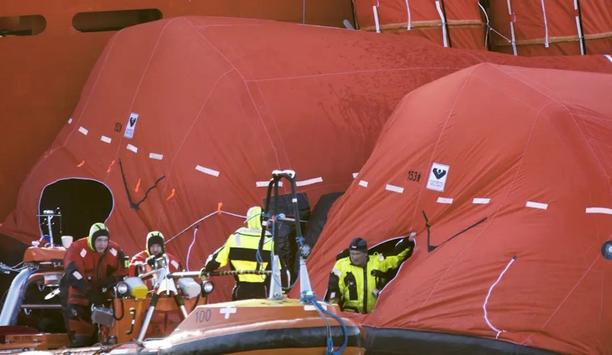The Panama Canal celebrated the eighth anniversary of its expansion program by announcing an increase to its draft and daily transits, all while continuing to manage the impact of climate variability and the challenge of securing water for the future.
Through an Advisory to Shipping, the Panama Canal announced that the maximum authorised draft was raised today from 46 to 47 feet (14.33 metres), and will increase to 48 feet (14.063 metres) on July 11. Additionally, a new booking slot for the Neopanamax locks will be added beginning on August 5, bringing the total number of transits to 35 ships per day.
Panama Canal’s continued progression
The Canal’s continued progression is informed by the current and projected water levels of Gatun Lake
Today’s updates build on improvements announced earlier in June, which included an increase in daily transits from 32 to 33 beginning on July 11, and again to 34 on July 22.
The Canal’s continued progression is informed by the current and projected water levels of Gatun Lake, and the arrival of the rainy season in the Panama Canal watershed.
Eight Years of Growth, Challenges and Progress
“This anniversary is distinct from previous ones since we have had to adapt our operations following the recent drought and the climatic variability affecting water levels at Lakes Gatun and Alhajuela. In this critical period, we have prioritised the well-being of the population, guaranteeing the supply of drinking water and, on the other hand, ensuring the reliability of the service to our customers,” said Panama Canal Administrator - Ricaurte Vásquez Morales.
The Expanded Canal opened on June 26, 2016, with thousands on-site to witness the inaugural transit of the container ship - Cosco Shipping Panama through the Agua Clara and Cocoli locks, marking the start of a new era for Panama and world commerce.
Panama Canal expansion
The Canal expansion was the largest enhancement project undertaken since the Panama Canal’s original opening in 1914, allowing the waterway to provide shipping lines, retailers, manufacturers and consumers with greater shipping options, better maritime service, enhanced supply chain reliability and sustainability.
The Expanded Canal also opened the waterway to 90 percent of the world’s liquefied natural gas (LNG) vessels for the first time. Additionally, it increased the route’s emission savings for customers by allowing a greater volume of cargo to be transported in fewer trips, reducing time and fuel significantly.
Expansion has ripple effect on local and global economy
The expansion has also caused a ripple effect on the local and global economy
The expansion has also caused a ripple effect on the local and global economy, as countless ports worldwide received larger ships and expanded to accommodate the more than 25,000 vessels that have transited the Neopanamax locks since 2016.
A total of 1,799 vessels transited the Expanded Canal between October 2023 and May 2024 alone. In this period, 1,123 (62.4 percent) were container ships.
Increased Capacity
Although the Neopanamax locks were initially expected to accommodate vessels with a maximum of 12,600 twenty-foot equivalent units (TEUs), the Panama Canal soon surpassed this threshold, thanks to the experience gained by operating the locks and through close collaboration with customers.
The new locks have since allowed for the passage of much larger ships, including containerships CMA CGM ZEPHYR, which has a capacity of 16,285 TEU’s, and the EVER MAX, with a maximum capacity of 17,312 TEU’s. The largest capacity vehicle carrier in the world, HÖEGH TARGET, and twin cruise ships Norwegian Bliss and Norwegian Encore have also completed record-breaking transits.
Connectivity
Given its privileged and strategic geographical location, Panama and the Panama Canal offer unsurpassed advantages to the world’s maritime trade.
Ships from all over the world transit the original and expanded Neopanamax locks daily
Ships from all over the world transit the original and expanded Neopanamax locks daily, with between 13,000 and 14,000 vessels passing through each year. The waterway serves more than 180 shipping routes, connecting 170 countries and approximately 1,920 ports around the world.
Transiting the Panama Canal considerably reduces voyage time for vessels traveling from the U.S. Gulf Coast to markets in Asia. Today, 71.5% of cargo transiting the Panama Canal originates or is destined for the United States.
The Water Challenge
The eighth anniversary of the Expanded Canal comes as the waterway continues to manage the impact of the prolonged dry season that last year limited its capacity for daily transits.
Despite the arrival of the rainy season, the challenge of water for Panama and the Panama Canal remains and serves as a reminder that climate change and its effects are a reality requiring immediate attention and concrete action.
Potential solutions
Potential solutions include the identification of alternative sources of water from the 51 watersheds and lakes in Panama, along with projects that can increase storage capacity to ensure water availability for the entire Panamanian population and the Canal’s operation, thereby ensuring its long-term sustainability.
At the same time, the Panama Canal is exploring additional short- and long-term solutions that can optimise the use and storage of water at the Canal for the benefit of both the local population and its own operations.
Panamanian Hands
All achievements have been made possible by the work and dedication of the more than 8,000 employees who make up the Panama Canal workforce.
They continue to uphold their commitment to managing, preserving, and operating the waterway in a responsible, competitive, and sustainable manner, serving as a global benchmark for excellence in service and operation for the maritime industry.










